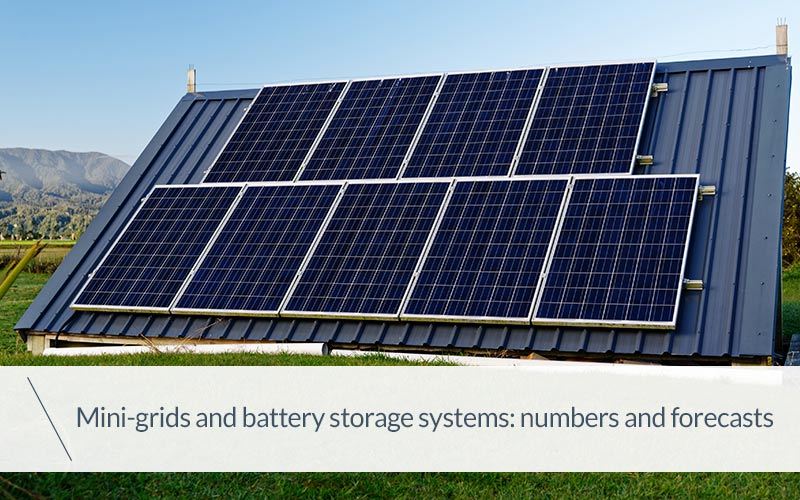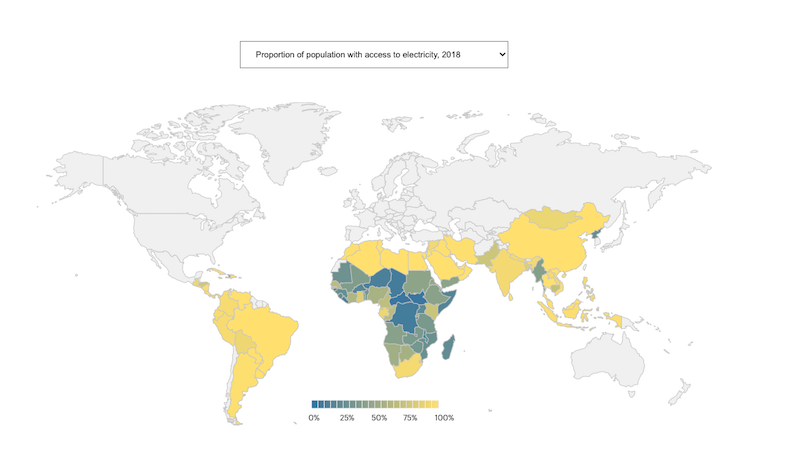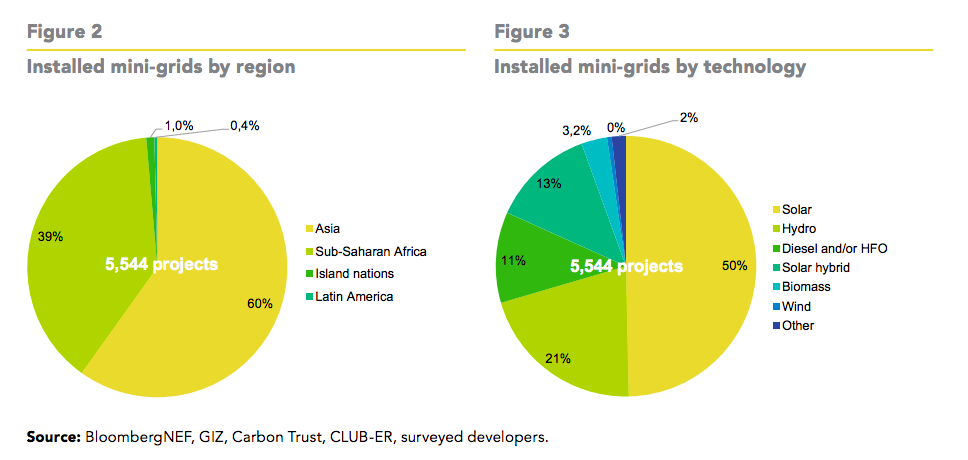
When considering the market for off-grid, mini-grid and battery installations, it’s impossible not to better analyze the big picture scenario, in the present as in the past. We are talking about access to electricity.
Data collected by IRENA (International Renewable Energy Agency) shows an encouraging outlook compared with the past, whereby we can find in 2017 a staggering 1 billion individuals with no access to electricity networks, compared to the 860 million people counted in 2018.
Unfortunately, whilst in the rest of the world the situation is steadfast, areas such as sub-Saharan Africa, India and several Asian Countries (Pakistan, Bangladesh and Myanmar amongst them), not forgetting South America and several small island Nations, are still very much in murky waters regards electrical network availability.
 This graphic representation of the situation, by IRENA, speaks loud and clear. It highlights the enormous difficulties faced on the African continent and in particular by Nigeria, Ethiopia, Uganda and The Democratic Republic of the Congo, with a sum of 600 million people without access to electrical energy, about 60% of the total population.
This graphic representation of the situation, by IRENA, speaks loud and clear. It highlights the enormous difficulties faced on the African continent and in particular by Nigeria, Ethiopia, Uganda and The Democratic Republic of the Congo, with a sum of 600 million people without access to electrical energy, about 60% of the total population.
According to forecasts, assuming the constancy of the current political and legal framework, and taking into account an increasing population, the number of people without access to electricity in the world declines to around 620 million by 2030 and then increases to 740 million by 2050. That accounts for roughly 8% of the global population.
Despite the difficult situation, we need to underline the efforts being made by these Nations to increase the share of the population with access to electrical energy.
For example, in Kenya, that share has moved from 25% to 75% in just five years. India alone accounts for 66% of the 1 billion of people who have gained access to electricity in developing Asia since 2000, and continues to make unprecedented progress towards universal electricity access, with a strong push from the government that resulted in almost 100 million people gaining access to electricity in 2018.
The importance of mini-grids
According to key sector operators and analysts, one of the most efficient and sustainable methods to facilitate access to electrical energy in these Countries is to invest in renewable energies, in particular in solar panels and mini-grids.
What are mini-grids?
Mini-grids are installations able to generate and distribute electrical energy without needing to feed into the national grid system: thus defined as off-grid systems.
In short, instead of building an electrical energy distribution network that carries energy from massive power plants to the whole nation, a localized installation, which caters to local needs, is built. Imagine the result of such an intervention in remote, secluded areas that still lack access.
By adopting renewable energy sources, the mini-grids bring several advantages:
- They have a reduced environmental impact
- They do not produce greenhouse gases or emit toxic substances into the area being electrified
- They bypass the need of the current domestic systems which use petrol and diesel generators
- They are more stable and cheaper than the huge and complex distribution systems currently widespread
The very best solution would be to create multiple mini-grids which can be connected to the national grid, so as to contribute adding energy to the principle distribution network when there is a surplus.
It’s a bit like the situation where private individuals install solar panels on the roofs of their houses to produce electrical energy, whilst maintaining their connection to the national grid. In rural areas however, it is a little more complex than this, and remote settlements are most likely to remain an off-grid system for a while.
Now let’s consider the storage systems of the electrical energy produced, which requires the use of batteries.
Mini-grids with battery storage systems
Energy production on systems based on mini-grids that are unconnected to the national grid have limits that can be overcome by the use of batteries.
Basically, there are two problems:
- The sun, obviously the best renewable energy source in these instances, is an energy source that varies according to weather conditions and exposure to the sun’s rays. Thus, with no energy storage system in place it would be possible to create an energy deficit when the primary energy source is in short supply. In other words, by being able to store the energy produced and unused, it can be accessed according to need.
- In the absence of a battery storage system, the alternative has always been the use of a petrol or diesel-run generator, with the associated costs and scarce availability of these fuels.
Therefore, connecting a mini-grid to a battery storage system really can make a big difference and considerably reduce the percentage of the world population with no access to electrical energy.
The size of the mini-grid market
An interesting report created by Mini-Grid Partnership (MGP) entitled “State of the Global Mini-grids market Report 2020” contains some very useful data which helps us to better understand the size of this market and forecasts for the future:
- In March 2020 there were 7,181 mini-grids in sub-Saharan Africa, Asia and in some small island nations and South America, of which 5,544 were operational.
- Of these 5,544 mini-grids, 63% use solar or hybrid solar systems, 21% hydroelectric systems and 11% fossil fuel/heavy oil systems.
- For solar hybrid mini-grids operating in isolated areas and serving productive-use (commercial and industrial) customers, LCOEs (levelized cost of electricity) ranged from USD 0.49–0.68/kWh. By contrast, LCOEs for diesel generators were USD 0.89–1.28/kWh for the same scenario.
- It is forecast that by 2030 there will be coverage for 111 million people in sub-Saharan Africa, Asia and the small island nations.
 Regarding battery energy storage systems, the report shows that 66% of mini-grid systems with battery storages installed in 2019 adopted lead batteries, and 32% lithium-ion batteries.
Regarding battery energy storage systems, the report shows that 66% of mini-grid systems with battery storages installed in 2019 adopted lead batteries, and 32% lithium-ion batteries.
A large change is expected in these proportions in the future due to a fall in the cost of lithium batteries.
In regard to the future, this is what the data tell us:
- By 2030, 238 million families will need access to electricity in sub-Saharan Africa, Asia and small island nations.
- Currently mini-grids can cover almost half of these users, for a total of 111 million households.
- This requires a capital investment of 128 billion dollars, to achieve universal electricity access.
- Mini-grid technology is the best option for many areas with low to medium population densities, and can be a solution for a high number of low-income families who lack access to electricity, as it is cheaper than alternative solutions.
The market for mini-grids remains nascent, and mini-grid projects often offer the least-cost option for delivering power to rural citizens who lack energy access. It’s no coincidence that use of this kind of system has jumped from 60 units in 2010 to 2,099 units by the end of February 2020. Let’s hope the trend continues.



